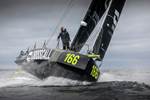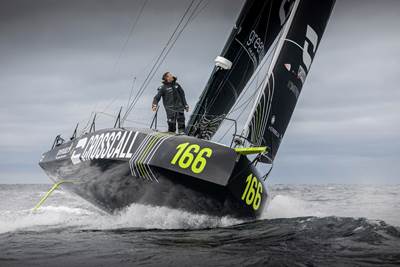Luna Rossa Prada Pirelli adopts Siemens Xcelerator portfolio for America’s Cup composite yacht
Critical digital tools and services increase design complexity, improve manufacturing repeatability and accelerate development for composite racing yacht construction, in and out of season.
Photo Credit, all images: Luna Rossa Prada Pirelli
Siemens Digital Industries Software (Waltham, Mass., U.S.) has announced that the Luna Rossa Prada Pirelli America’s Cup team is using the Siemens Xcelerator portfolio of software and services to design, simulate and optimize its racing yacht for the upcoming 37th America’s Cup challenge.
Manufactured with carbon fiber composites, the building process for required nearly 10 months and more than 30,000 work hours of over 25 people and 40 members of the design team. For the construction of the hull and composite components, 5,000 square meters of carbon fiber were used in the different materials that make up the structural core. The prototype was conceived, designed and built at the Luna Rossa Prada Pirelli base in compliance with the rules imposed by the 37th America’s Cup Protocol.
According to Matteo Ledri, head of CFD, Luna Rossa Prada Pirelli team, the portfolio will provide critical tools that will “allow the team to design, analyze and evaluate all aspects of the boat’s hydraulics and fluid-dynamic performance. Using Siemens’ software, the hull, foils, rudder and sails can be analyzed as part of the digital twin, to understand how each surface responds to the changes in the project parameters, thus speeding up our work.”
The hull, foils, rudder and sails are designed and analyzed virtually using Simcenter STAR CCM+ software to understand how sails, hull and the complex hydrodynamics of the hydrofoil respond to the changes in the project parameters. Simcenter Amesim software is used to simulate all on-board hydraulic lines and optimize performance, an essential aspect given that on-board hydraulic power for the aerial parts of the boat is generated by four cyclors using pedal power.
Siemens Xcelerator is used to understand how sails, hull and the complex hydrodynamics of the hydrofoil respond to the changes in the project parameters.
Luna Rossa Prada Pirelli is also taking advantage of Xcelerator Share, the cloud-based collaboration capability in Siemens Xcelerator as a Service, to effectively manage increased design complexity, improve manufacturing repeatability across the growing number of parts undergoing thousands of engineering changes per year, in and out of racing season. In the highly competitive America’s Cup environment, these advanced shape description capabilities and high-fidelity CFD simulations of an extreme class of sailing boats enable team to meet their needs on the timetables demanded by global racing competitions.
Moreover, Siemens Xcelerator as a Service enables a high degree of automation, so the Luna Rossa Prada Pirelli team can fully leverage the power of modern high-performance computing (HPC) clusters, running thousands of simulations per day to quickly explore the characteristics of new designs in different environmental conditions. In addition, Siemens provides a dedicated support service to assist the team in extracting the maximum value out of their investment. The agreement also includes Siemens’ NX software, which Luna Rossa Prada Pirelli licensed to start evaluating its potential with a view to its future introduction.
“The Luna Rossa Prada Pirelli team’s selection of Siemens Xcelerator as a Service is another proof point that organizations at the bleeding edge of innovation are using our solutions to bring their ideas to life and find new areas for true innovation,” Franco Megali, vice president and CEO Italy, Israel and Greece, Siemens Digital Industries Software, adds. “Whether that’s teams competing in the world’s most extreme sailing races, taking new vehicles to the edge of space or building a more sustainable future for us all, pioneers are choosing our solutions.”
Related Content
Cutting 100 pounds, certification time for the X-59 nose cone
Swift Engineering used HyperX software to remove 100 pounds from 38-foot graphite/epoxy cored nose cone for X-59 supersonic aircraft.
Read MoreCo-molding SMC with braided glass fiber demonstrates truck bed potential
Prepreg co-molding compound by IDI Composites International and A&P Technology enables new geometries and levels of strength and resiliency for automotive, mobility.
Read MoreCarbon fiber composite pallet revolutionizes freight industry
LOG Point Pallet fuses advanced materials with innovative design and manufacturing to improve supply chains worldwide.
Read MoreWelding is not bonding
Discussion of the issues in our understanding of thermoplastic composite welded structures and certification of the latest materials and welding technologies for future airframes.
Read MoreRead Next
Grand Largue Composites, Sicomin enable flax fiber-built Class40 racing yacht
Fibers, fabrics, epoxy resins and adhesives from Sicomin helped realize the lightweight, strong and stiff Crosscall yacht, capable of tackling extreme ocean racing conditions.
Read MoreNext-gen fan blades: Hybrid twin RTM, printed sensors, laser shock disassembly
MORPHO project demonstrates blade with 20% faster RTM cure cycle, uses AI-based monitoring for improved maintenance/life cycle management and proves laser shock disassembly for recycling.
Read MoreScaling up, optimizing the flax fiber composite camper
Greenlander’s Sherpa RV cab, which is largely constructed from flax fiber/bio-epoxy sandwich panels, nears commercial production readiness and next-generation scale-up.
Read More












